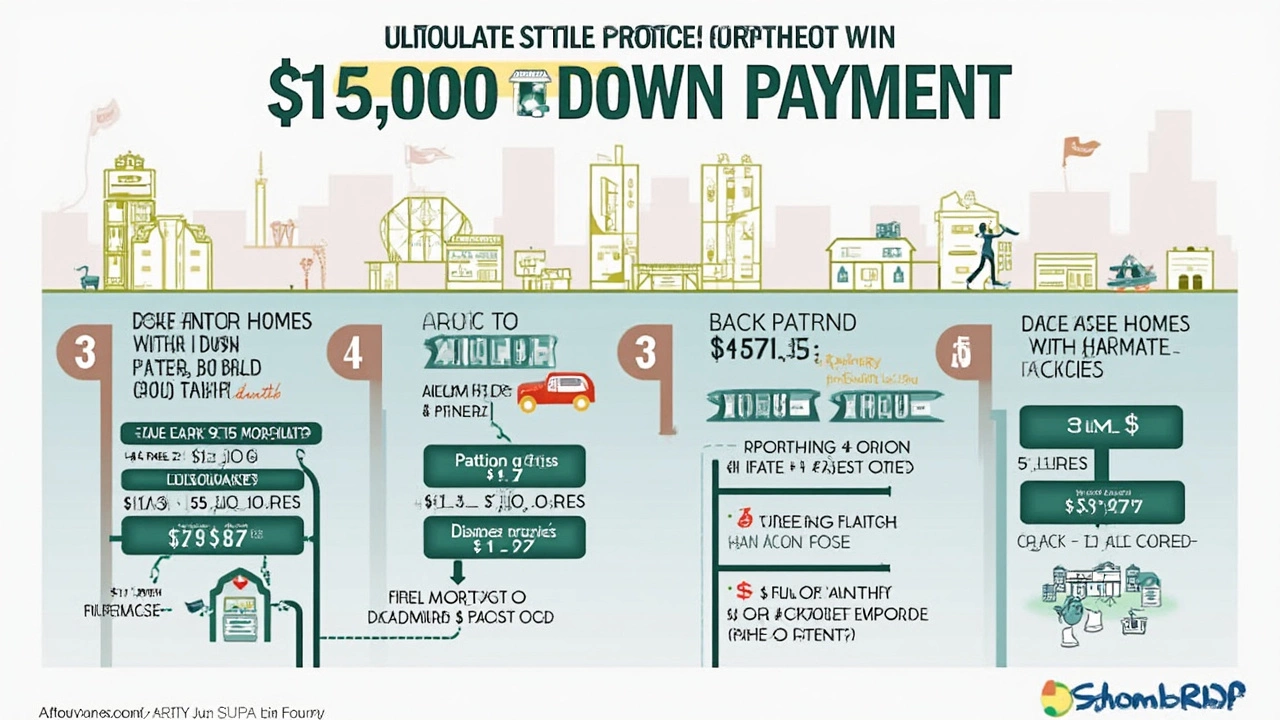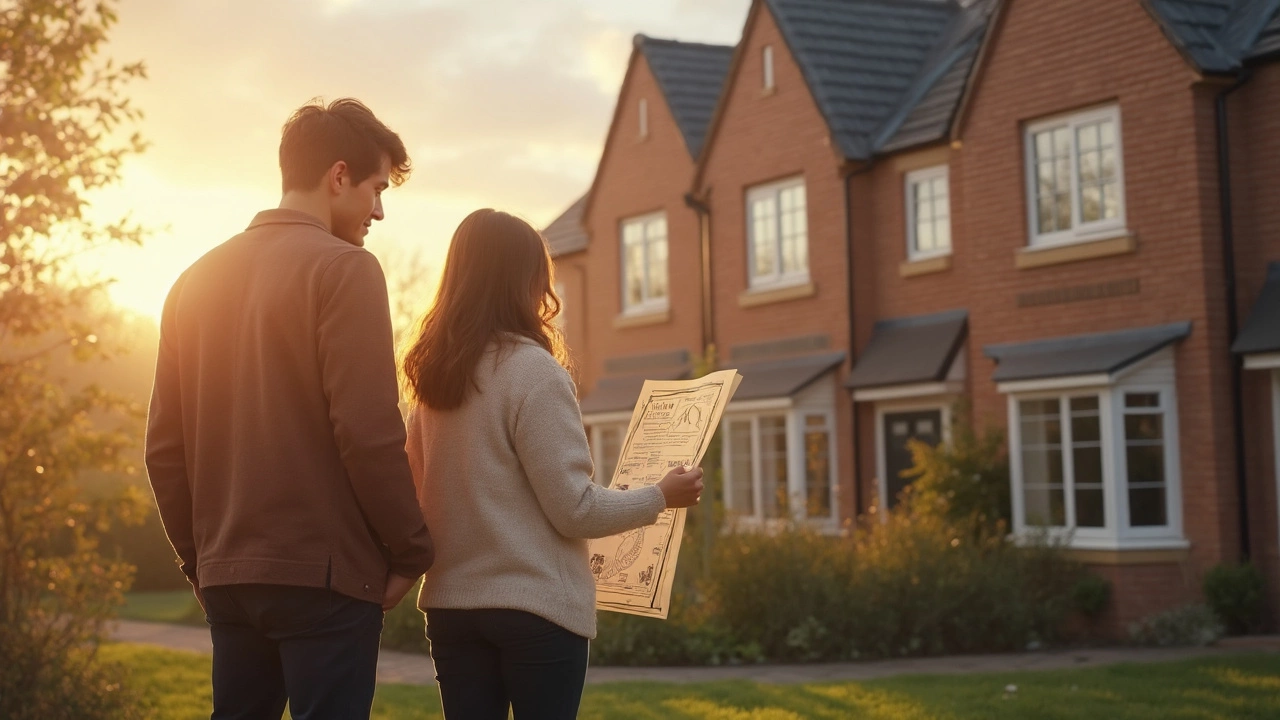How Much House Can I Afford with $10,000 Down?
 Feb, 18 2025
Feb, 18 2025
So you've got $10,000 set aside and you're dreaming about getting into your first home. Exciting times, right? But here's the million-dollar question: How much house can you actually afford with that chunk of change? Let's break it down without over-complicating things.
First off, understanding your budget is key. Your down payment is just one piece of the puzzle. You've got to factor in your income, current debts, and lifestyle choices. A handy rule of thumb? Try not to use more than 30% of your monthly income on housing costs. This way, you're not living paycheck to paycheck.
- Understanding Your Budget
- Considering Mortgage Options
- Location and Lifestyle Impact
- Tips to Increase Buying Power
Understanding Your Budget
Alright, let's get real about your finances. Diving into the world of home buying starts with knowing what you can comfortably afford. It's not just about the $10,000 down payment; it's about the whole financial picture.
Income and Monthly Payments
A good measure is to dedicate no more than 30% of your monthly income to housing costs. This ensures you have enough left over for the other essentials—and maybe a little fun too. So, start by tallying up your monthly income and calculate what 30% of that number looks like.
Factoring in Debts
Already have some debts? You're not alone. Whether it's student loans or credit card balances, these affect what you can afford. Lenders look at your debt-to-income ratio, meaning your total monthly debts compared to your income. Ideally, this figure should be below 36%.
Here's a snippet of a typical budget breakdown to help you visualize:
| Item | Percentage of Income |
|---|---|
| Housing Costs | 30% |
| Debt Payments | Up to 36% |
| Savings and Other Costs | 34% |
Build a Cushion
Keeping some savings beyond the mortgage is crucial for emergencies or unforeseen home expenses. Aim to have at least three months' worth of living expenses as a safety net.
So, before jumping into the market, take a good look at your budget. This gives you a better roadmap and prevents surprises down the line. Happy budgeting, and here's to a smooth journey to home ownership!
Considering Mortgage Options
When you’re looking at homes and you know you’ve only got a $10,000 down down payment to play with, it’s crucial to find the right mortgage option to make your dream home a reality. Let's look at the types of mortgages you might consider.
1. Conventional Loans
These are the most popular ones out there, and they generally require a 20% down payment. But here's the secret: You can get away with less if you're willing to pay private mortgage insurance (PMI). Your $10K might get you in the door, but be ready for those added PMI costs.
2. FHA Loans
For first-time home buyers, FHA loans can be a lifesaver. They’re backed by the government, meaning they’re less risky for lenders. The best part? They only require a down payment of 3.5% of the home purchase price. So, with $10,000, your budget can stretch quite a bit.
| Loan Type | Down Payment Percentage | Minimum Credit Score |
|---|---|---|
| Conventional | 5%-20% | 620 |
| FHA | 3.5% | 580 |
3. VA Loans
Are you a veteran or active military? VA loans could be your ticket to home ownership with zero down payment. Yep, you read that right—no down payment needed, but you’ll still need to factor in a funding fee. It’s a stellar option for those who qualify.
4. State Programs
Be sure to check if there are any state-specific programs offering assistance to first-time homebuyers. Some offer direct financial assistance or special loans that might make the numbers work better for you.
Remember, every dollar counts, so shop around and talk to several lenders to see who can offer you the best deal. It might take some legwork, but understanding your mortgage options can really enhance your purchasing power, even with a modest down payment.

Location and Lifestyle Impact
When it comes to buying a home, where you choose to plant roots matters—big time. Your choice of location doesn’t just influence your commute or the view from your window. It can also dictate how much house you can afford. The truth is, homes in urban areas typically come with a heftier price tag compared to those in suburban or rural settings.
Why is that? Well, besides the allure of being near bustling city life, urban demand keeps prices high. So, if you're set on city lights, you might need to adjust your expectations.
Now, let's throw the lifestyle factor into the mix. Are you a café hopper who loves being in the thick of it? Or perhaps you prefer a quieter, more spread-out suburb with space to garden? Your lifestyle choices will subtly sway how far your $10,000 down payment can take you.
Factors That Impact Cost
- Proximity to city centers: Close proximity means higher prices.
- Local amenities: Areas with better schools, parks, or shopping facilities might cost more.
- Future development plans: Infrastructure projects could mean future price hikes.
Here’s a pro tip: Check out upcoming infrastructure projects, like new roads or public transport links. These can significantly shift property values over time.
Understanding Sydney's Real Estate
For example, in Sydney, median house prices are significantly higher near the central business district (CBD). On average, properties closer to the CBD can hover around A$1.5 million, whereas homes in the outer regions, like Penrith, might linger around A$750,000. Quite the difference, huh?
As you weigh your options, figure out what's most important to you. Is it the buzzing vibe of the city, or perhaps a spacious backyard? Use these insights to make a decision that meets both your budget and lifestyle needs.
Tips to Increase Buying Power
Nailing down your house affordability can dramatically change with a few smart moves. Let's look at some practical ways to boost your home-buying capacity without stretching your wallet to thin.
Improve Your Credit Score
Your credit score is a key factor for lenders when determining the interest rate you'll get. A higher score often means a lower rate, which can ultimately reduce your monthly mortgage payment. Start by paying off existing debts and keeping your credit utilization low. Also, regularly check for errors in your credit report that could be dragging your score down.
Explore Different Loan Options
Not all mortgage options are created equal. You can look into FHA loans, which often allow for smaller down payments and might be friendlier for first-time buyers. VA loans are another option for veterans and active service members, requiring no down payment in many cases. Comparing rates from different lenders can make a significant difference too.
Boost Your Savings
The more you put down, the better. Increase your buying power by setting aside bonuses, tax refunds, or side gig earnings toward your home purchase. Every extra dollar saved can lower your loan amount, reducing long-term interest costs. A higher down payment might also help you avoid private mortgage insurance (PMI), which is an extra cost if your down payment is less than 20%.
Understand Local Market Trends
Sometimes it pays to know when to strike. Housing markets aren’t static; they fluctuate. Understanding when prices tend to drop could give you an edge. Check out historical data, which might reveal times when prices typically soften, allowing you to get more bang for your buck.
Consider Other Expenses
Don’t forget to factor in property taxes, insurance, and potential home repairs. These can all eat into what you can actually afford monthly. Budgeting for these costs ahead of time will keep the panic at bay and ensure you're not hit with surprise expenses down the track.